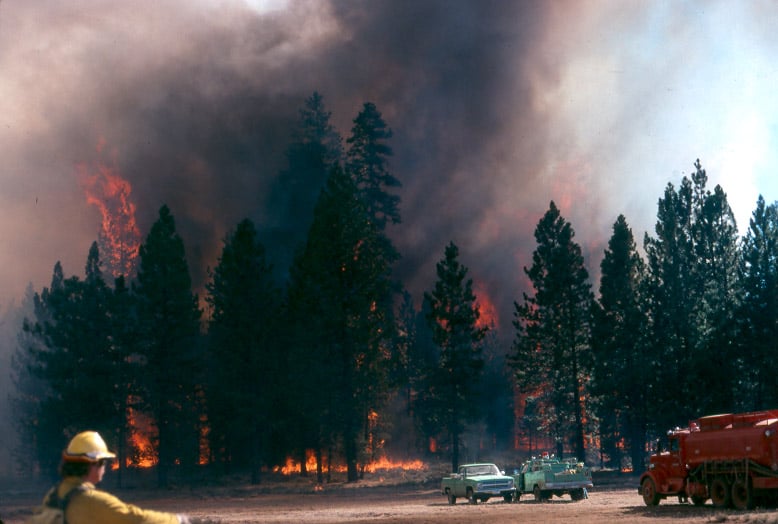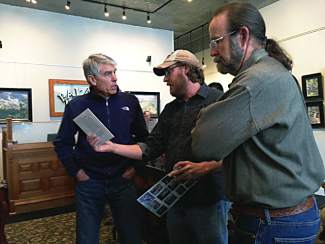I can’t vouch for the accuracy of this Preview. I received on an email trail that supposedly starts from Wyden’s office. I am as likely as the next person to be bamboozled. Still, just in case, I thought it worth sharing. As I reformatted this from the email, I had many thoughts, but I will reserve them until I find out for sure that it’s not an elaborate and brilliantly crafted hoax.
For too long, Oregon’s 2.1 million acres of O&C grant lands have been ground zero for the battle between those seeking to halt logging in the Northwest and those seeking to return to the unsustainable logging levels of a bygone era.
This legislation would end the gridlock by using science to guide management of the O&C lands, roughly doubling timber harvests over the next 10 years compared to the last 10 years and providing certainty for local communities. At the same time, this bill will permanently protect old growth trees, ensure habitat for sensitive species, and put in place strong safeguards for drinking water and fish.
This bill amends the Oregon and California Revested Lands Sustained Yield
Management Act of 1937, so the O&C Grant Lands in 18 Oregon counties are
managed to foster long-term forest and environmental health while producing
sustainable levels of timber.
It achieves these goals and resolves longstanding land management disputes by separating the Oregon and California Grant Lands into roughly equal “forestry emphasis” and “conservation emphasis” areas.
Ensuring Predictable and Sustainable Timber Harvests
The legislation requires the Secretary of the Interior to provide a long-term sustained yield of timber in forestry emphasis areas, using forestry principles developed by Drs. Norm Johnson and Jerry Franklin, two highly respected Northwest scientists. It includes specific directions for managing dry and moist forests. In forestry emphasis areas, sustainable timber production is a clear management priority, eliminating the uncertainty and conflicting direction that have contributed to the decline in forest management on O&C lands.
Over the past decade, harvests have averaged 149.5 million board feet per year, and were at just 167 million board feet in 2012, according to the BLM. Even that low level is likely to fall off by more than 30% in about a decade, according to the agency’s projections. The status quo, thinning only approach leads to only about 115 million board feet of harvests in about 10 years, unless the agency can move forward with a new strategy for the O&C forests. This bill represents a new strategy that works and can become law.
This strategy takes the most controversial harvests off the table. It ensures that:
● Old growth stands over 120 years old and trees over 150 years old cannot be harvested.
● Timber harvests and thinning projects cannot significantly impact stream
quality, fish, highly erodible land, wetlands, endangered or threatened
species, or tribal cultural sites.
● Spotted owl nest trees are protected and harvests that may impact endangered species require coordination with the U.S. Fish and Wildlife
Service.
Moist Forests
● Harvests must retain 30 percent of the original trees in a stand. Trees along streams can count toward this 30 percent, but any old growth trees protected are above and beyond this threshold. The remaining trees are to be no uniformly spaced throughout a stand, ensuring more natural distribution of trees.
● Stands in the moist forests will be harvested when the average age of the
trees in the stand reach 80 to 120 years of age.
● Continues thinning projects that leave more than 50 percent of trees in stands.
Dry Forests
● Resiliency to fire is the management emphasis for dry forest stands.
● Harvesting to reduce the density of trees in dry forests is promoted;
however, one third of all of the dry forests must be selected to remain as
denser landscape scale patches for endangered species.
● Harvesting must ensure the oldest 35 percent of the trees in an area remain after the operation.
● Provides new flexibility for county governments to reduce fire danger within half a mile of homes, and private landowners to within 100 feet of their own homes.
Streamlining Environmental Reviews
This bill would cut environmental and court reviews of proposed timber sales nearly in half, taking commonsense steps to streamline review procedures, while maintaining environmental laws.
While federal Environmental Impact Statements take an average of 3.6 years,
according to one study, this bill would require the BLM to finalize its O&C
environmental impact statements within 18 months after the bill becomes law.
First, it streamlines the timelines for environmental and judicial reviews;
Second, it eliminates the individual environmental impact statements for each timber sale, and replaces them with two large-scale environmental impact statements – one each for dry and moist forests – that examine 10years’ worth of timber sales on O&C lands;
Third, it requires frontloaded coordination between federal agencies during
environmental reviews; and Fourth, it requires upfront studies of areas to prioritize treatments.
● The streamlined EIS procedures continue to allow for judicial review, but
eliminate unnecessary delays by setting strict, but achievable deadlines. For example, the draft Environmental Impact Statements must be released within a year of enactment, and finalized within 18 months of enactment.
● Lawsuits must be filed no later than 30 days after a final decision is made by the BLM. In addition, only those who participated in the BLM comment
process and raised their objections are eligible to file suit. An expedited court procedure requires trials to begin within 180 days, to ensure lawsuits are heard in a timely manner.
● Once the 10year EIS is finalized, the BLM must simply document that a
proposed project meets the criteria analyzed in the EIS, rather than
conducting a project specific environmental review. Projects may only be challenged on the grounds that they failed to conform with the EIS.
● Eliminates the time consuming “survey and manage” requirements of the
Northwest Forest Plan on the forestry emphasis areas of the O&C lands.
● The US Fish and Wildlife Service and National Marine Fisheries Service will conduct a five year check in, to ensure operations and impacts to species follow the original EIS.
● This bill leaves the Endangered Species Act untouched, and the habitat for
the plants and animals that the Endangered Species Act protects are managed
to help try to recover these species.
Protecting Streams, Drinking Water and Fish
The bill creates the first specific legislative protections for aquatic areas and watersheds on O&C lands, by requiring the BLM to protect and restore water quality for drinking water and aquatic species in streams and lakes.
● It protects water quality for all O&C lands. In forestry emphasis areas,
riparian reserves would encompass an area 150 feet from streams containing fish, and 75 feet from other streams. The modified reserves allow for greater timber harvests, while maintaining habitat and water quality protections.
● Within those reserves, thinning is allowed to improve forest and stream
health. Thinning is allowed for trees under 80 years old in moist forests,
and for trees under 150 years in dry forests. An additional buffer of 75
feet on streams without fish can be used for sustainable harvests in stands
less than 80 years of age.
● In conservation emphasis areas, riparian reserves are permanently protected under the same approach currently used under the Northwest
Forest Plan.
● Watershed assessments will be conducted to identify streams most in
need of protection. Riparian reserves can be adjusted based on those
assessments.
● Permanent road construction is prohibited in key watersheds, and the
BLM is directed to generally decrease the quantity of roads on its lands.
● Sets aside $1 million per year for transporting and placing large trees in
streams to improve water quality and fish habitat.
● To speed up restoration accomplishments, the following clearly beneficial
restoration activities are excluded from analysis typically required by
NEPA: Placing trees in streams to benefit fish species, planting of native
trees along streams, replacing culverts that prevent fish from migrating,
and removal of user created roads.
● The removal of excess roads on BLM lands is a priority. A new “Legacy
Roads and Trails” program is created for these lands and is authorized to
spend $5 million annually.
Management in the Conservation Areas
Conservation areas will be managed for general conservation benefits, including old growth protection, watershed health, native wildlife, climate management, recreation, and tourism.
● In the conservation areas, road building with limited exceptions and
mineral development is prohibited. Timber harvests are allowed, but are
limited to those that improve habitat and forest health. This is achieved by
thinning and retaining older and larger trees.
Portions of the conservation areas will be designated for more specific management and additional protections:
● Oregon Treasures: Wild Rogue Wilderness expansion (56,400 acres),
Rogue River Wild and Scenic Rivers expansion (93 miles), Molalla
Recreational River designation (15.1 miles), Table Rock Fork Recreational
River designation (6.2 miles), Chetco Wild and Scenic River update
● Devil’s Staircase Wilderness: 30,540 acres
● Cascade Siskiyou National Monument Expansion: 5,700 acres
● Illinois Valley Salmon and Botanical Area: 16,300 acres
● Recreation and Backcountry Areas: Rogue National Recreation Area
(nearly 95,000 acres); Molalla National Recreation Area (24,000 acres);
Pacific Crest Trail Protection Corridor (8,200 acres); Primitive
Backcountry Areas: Grizzly Peak (3,000 acres), Dakubetede (27,700
acres), Wellington Wildlands (5,700 acres), Mungers Butte (9,800 acres),
Brummitt Fir (1,500 acres), Crabtree Valley (2,000 acres)
● Drinking Water Special Management Units (total acres: 47,000):
McKenzie, Hillsboro, Clackamas, and Springfield Drinking Water Special
Management Units.
● Special Environmental Zones: 95,600 acres of current or proposed
BLM Areas of Critical Environmental Concern
● Wild and Scenic Rivers (total miles: 47): Nestucca River, Walker Creek,
North Fork Silver Creek, Lobster Creek, Jenny Creek, Spring Creek,
Franklin Creek and Wasson Creek
Increasing Revenues for Counties
The revenues generated from the sale of timber from these lands will be shared with the counties and pay for the cost of managing the lands, without increasing the federal deficit.
● Every county is guaranteed at least as much funding as it would have
received under the O&C Act of 1937, if it had elected to receive those funds
in Fiscal Year 2013.
● The BLM will receive 25 percent of revenues – up to $20 million – to fund
management of the O&C lands.
● Each year, $4 million of the revenue generated from timber harvests will go to the U.S. Treasury, to prevent an increase in the federal deficit.
● The remaining revenue shall be paid annually to the O&C counties.
● If there is insufficient revenue to meet the county’s minimum payment,
money will be taken from the U.S. Treasury payment and then the BLM
administrative repayment to cover the balance.
Consolidating the Checkerboard of Land Ownership
The bill provides new ways to consolidate land ownership and reduce the
checkerboard of public and private lands. Within six months of the date of
enactment, BLM will identify lands suitable for sale or exchange with private or state owned lands. BLM is authorized to sell or exchange Federal land in order to consolidate land in an effort to improve management efficiency and productivity or to improve the ecological value of conservation areas.
● BLM will sell a portion of the acres it identifies or has previously identified for disposal and use the revenue from the sales to purchase land near to BLM holdings.
● If land in forest emphasis areas is sold, the land purchased with these funds will be managed as a forest emphasis area. Sales of conservation emphasis area lands shall be used to purchase lands for conservation emphasis.
Additional provisions
● This Act sets aside 50,000 acres for special joint management and research
by the BLM and Oregon State University and other institutions of higher
education. The Secretary will choose lands near Oregon State University
from both the timber emphasis areas and the conservation areas. The lands
will be managed to conduct ecological forestry demonstration projects,
research and monitor suspected impacts, and produce timber. If the land fails to be actively managed, it will revert back to management by the BLM.
● Land is restored to two Oregon tribes: the Cow Creek Band of the Umpqua
Tribe of Indians, and the Confederated Tribes of Coos, Lower Umpqua, and
nds may not be used for gaming, and commercial forestry activities on these lands must follow applicable federal laws, and there will be no net loss of O&C lands.
● Management restrictions on the Coquille Tribe’s lands are lifted to make their treatment equal to other tribal” (sorry that’s the way the email ended).



